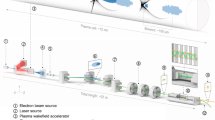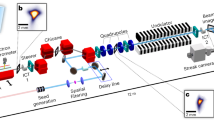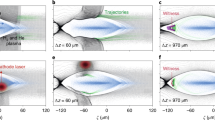Abstract
The possibility to accelerate electron beams to ultra-relativistic velocities over short distances by using plasma-based technology holds the potential for a revolution in the field of particle accelerators1,2,3,4. The compact nature of plasma-based accelerators would allow the realization of table-top machines capable of driving a free-electron laser (FEL)5, a formidable tool to investigate matter at the sub-atomic level by generating coherent light pulses with sub-ångström wavelengths and sub-femtosecond durations6,7. So far, however, the high-energy electron beams required to operate FELs had to be obtained through the use of conventional large-size radio-frequency (RF) accelerators, bound to a sizeable footprint as a result of their limited accelerating fields. Here we report the experimental evidence of FEL lasing by a compact (3-cm) particle-beam-driven plasma accelerator. The accelerated beams are completely characterized in the six-dimensional phase space and have high quality, comparable with state-of-the-art accelerators8. This allowed the observation of narrow-band amplified radiation in the infrared range with typical exponential growth of its intensity over six consecutive undulators. This proof-of-principle experiment represents a fundamental milestone in the use of plasma-based accelerators, contributing to the development of next-generation compact facilities for user-oriented applications9.
This is a preview of subscription content, access via your institution
Access options
Access Nature and 54 other Nature Portfolio journals
Get Nature+, our best-value online-access subscription
$29.99 / 30 days
cancel any time
Subscribe to this journal
Receive 51 print issues and online access
$199.00 per year
only $3.90 per issue
Buy this article
- Purchase on Springer Link
- Instant access to full article PDF
Prices may be subject to local taxes which are calculated during checkout




Similar content being viewed by others
Data availability
The data that support the findings of this study are available from the corresponding author on reasonable request.
References
Mangles, S. P. D. et al. Monoenergetic beams of relativistic electrons from intense laser–plasma interactions. Nature 431, 535–538 (2004).
Faure, J. et al. Controlled injection and acceleration of electrons in plasma wakefields by colliding laser pulses. Nature 444, 737–739 (2006).
Litos, M. et al. High-efficiency acceleration of an electron beam in a plasma wakefield accelerator. Nature 515, 92–95 (2014).
Gonsalves, A. J. et al. Petawatt laser guiding and electron beam acceleration to 8 GeV in a laser-heated capillary discharge waveguide. Phys. Rev. Lett. 122, 084801 (2019).
Nakajima, K. Towards a table-top free-electron laser. Nat. Phys. 4, 92–93 (2008).
Hartmann, N. et al. Attosecond time–energy structure of X-ray free-electron laser pulses. Nat. Photonics 12, 215–220 (2018).
Pandey, S. et al. Time-resolved serial femtosecond crystallography at the European XFEL. Nat. Methods 17, 73–78 (2020).
Pompili, R. et al. Energy spread minimization in a beam-driven plasma wakefield accelerator. Nat. Phys. 17, 499–503 (2021).
Assmann, R. W. et al. Eupraxia conceptual design report. Eur. Phys. J. Spec. Top. 229, 3675–4284 (2020).
Argyropoulos, T. et al. Design, fabrication, and high-gradient testing of an X-band, traveling-wave accelerating structure milled from copper halves. Phys. Rev. Accel. Beams 21, 061001 (2018).
Tajima, T. & Dawson, J. M. Laser electron accelerator. Phys. Rev. Lett. 43, 267 (1979).
Modena, A. et al. Electron acceleration from the breaking of relativistic plasma waves. Nature 377, 606–608 (1995).
Sprangle, P., Esarey, E. & Krall, J. Laser driven electron acceleration in vacuum, gases, and plasmas. Phys. Plasmas 3, 2183–2190 (1996).
Blumenfeld, I. et al. Energy doubling of 42 GeV electrons in a metre-scale plasma wakefield accelerator. Nature 445, 741–744 (2007).
André, T. et al. Control of laser plasma accelerated electrons for light sources. Nat. Commun. 9, 1334 (2018).
Deng, A. et al. Generation and acceleration of electron bunches from a plasma photocathode. Nat. Phys. 15, 1156–1160 (2019).
Lindstrøm, C. A. et al. Energy-spread preservation and high efficiency in a plasma-wakefield accelerator. Phys. Rev. Lett. 126, 014801 (2021).
Kirchen, M. et al. Optimal beam loading in a laser-plasma accelerator. Phys. Rev. Lett. 126, 174801 (2021).
Wang, W. et al. Free-electron lasing at 27 nanometres based on a laser wakefield accelerator. Nature 595, 516–520 (2021).
Chen, P. et al. Acceleration of electrons by the interaction of a bunched electron beam with a plasma. Phys. Rev. Lett. 54, 693 (1985).
Ferrario, M. et al. SPARC_LAB present and future. Nucl. Instrum. Methods B 309, 183–188 (2013).
Ferrario, M. et al. Laser comb with velocity bunching: preliminary results at SPARC. Nucl. Instrum. Methods A 637, S43–S46 (2011).
Serafini, L. & Ferrario, M. Velocity bunching in photo-injectors. AIP Conf. Proc. 581, 87–106 (2001).
Pompili, R. et al. Femtosecond timing-jitter between photo-cathode laser and ultra-short electron bunches by means of hybrid compression. New J. Phys. 18, 083033 (2016).
Cianchi, A. et al. Six-dimensional measurements of trains of high brightness electron bunches. Phys. Rev. Accel. Beams 18, 082804 (2015).
Biagioni, A. et al. Gas-filled capillary-discharge stabilization for plasma-based accelerators by means of a laser pulse. Plasma Phys. Control. Fusion 63, 115013 (2021).
Pompili, R. et al. Compact and tunable focusing device for plasma wakefield acceleration. Rev. Sci. Instrum. 89, 033302 (2018).
Romeo, S. et al. Beam-based characterization of plasma density in a capillary-discharge waveguide. AIP Adv. 11, 065217 (2021).
Shpakov, V. et al. First emittance measurement of the beam-driven plasma wakefield accelerated electron beam. Phys. Rev. Accel. Beams 24, 051301 (2021).
Marocchino, A. et al. Efficient modeling of plasma wakefield acceleration in quasi-non-linear-regimes with the hybrid code Architect. Nucl. Instrum. Methods Phys. Res. A 829, 386–391 (2016).
Rosenzweig, J. B. et al. Plasma wakefields in the quasi‐nonlinear regime. AIP Conf. Proc. 1299, 500–504 (2010).
Reiche, S. GENESIS 1.3: a fully 3D time-dependent FEL simulation code. Nucl. Instrum. Methods Phys. Res. A 429, 243–248 (1999).
Gorobtsov, O. Y. et al. Statistical properties of a free-electron laser revealed by Hanbury Brown–Twiss interferometry. Phys. Rev. A 95, 023843 (2017).
Pompili, R. et al. Time-resolved study of nonlinear photoemission in radio-frequency photoinjectors. Opt. Lett. 46, 2844–2847 (2021).
Ferrario, M. et al. Experimental demonstration of emittance compensation with velocity bunching. Phys. Rev. Lett. 104, 054801 (2010).
Behrens, C. & Gerth, C. On the limitations of longitudinal phase space measurements using a transverse deflecting structure. Proc. DIPAC09 TUPB44 (2009).
Löhl, F. & Schreiber, S. et al. Measurements of the transverse emittance at the FLASH injector at DESY. Phys. Rev. Accel. Beams 9, 092802 (2006).
Pompili, R. et al. Focusing of high-brightness electron beams with active-plasma lenses. Phys. Rev. Lett. 121, 174801 (2018).
Biagioni, A. et al. Temperature analysis in the shock waves regime for gas-filled plasma capillaries in plasma-based accelerators. J. Instrum. 14, C03002 (2019).
Barov, N. & Rosenzweig, J. B. Propagation of short electron pulses in underdense plasmas. Phys. Rev. E 49, 4407 (1994).
Rossetti Conti, M. et al. Electron beam transfer line design for plasma driven free electron lasers. Nucl. Instrum. Methods Phys. Res. A 909, 84–89 (2018).
Quattromini, M. et al. Focusing properties of linear undulators. Phys. Rev. Accel. Beams 15, 080704 (2012).
Hogan, M. et al. Measurements of high gain and intensity fluctuations in a self-amplified, spontaneous-emission free-electron laser. Phys. Rev. Lett. 80, 289 (1998).
Massimo, F., Atzeni, S. & Marocchino, A. Comparisons of time explicit hybrid kinetic-fluid code Architect for plasma wakefield acceleration with a full PIC code. J. Comput. Phys. 327, 841–850 (2016).
Tzoufras, M. et al. Beam loading in the nonlinear regime of plasma-based acceleration. Phys. Rev. Lett. 101, 145002 (2008).
Chao, A. W. et al. Handbook of Accelerator Physics and Engineering (World Scientific, 2013).
Ariniello, R. et al. Transverse beam dynamics in a plasma density ramp. Phys. Rev. Accel. Beams 22, 041304 (2019).
Ferrario, M. et al. EuPRAXIA@SPARC_LAB design study towards a compact FEL facility at LNF. Nucl. Instrum. Methods Phys. Res. A 909, 134–138 (2018).
Vaccarezza, C. et al. EUPRAXIA@SPARC_Lab: beam dynamics studies for the X-band Linac. Nucl. Instrum. Methods Phys. Res. A 909, 314–317 (2018).
Petrillo, V. et al. Free electron laser in the water window with plasma driven electron beams. Nucl. Instrum. Methods Phys. Res. A 909, 303–308 (2018).
Huang, Z. & Kim, K. J. Review of x-ray free-electron laser theory. Phys. Rev. Accel. Beams 10, 034801 (2007).
Acknowledgements
This work has been partially supported by the European Commission in the Seventh Framework Programme, grant agreement 312453-EuCARD-2, the European Union Horizon 2020 research and innovation programme, grant agreement no. 653782 (EuPRAXIA), the INFN with the GRANT73/PLADIP grant, SL_COMB2FEL and PLASMAR collaboration with the ENEA FSN-FUSPHY Division. The work of A.Z. was partially supported by the ISF foundation. We thank D. Pellegrini for the development of the high-voltage discharge pulser and F. Anelli, M. Del Franco and A. Liedl for the technical support. We also thank all the machine operators involved in the experimental run.
Author information
Authors and Affiliations
Contributions
M.F., E.C., A.C., A.P. and R.P. planned the experiment. A.P. and R.P. managed the experiment, with inputs from all the co-authors. A.B. provided the plasma characterization. A.P. and A.S. managed the FEL beamline. G.C. and M.G. managed the FEL diagnostics. A.C. and V.S. managed the beam diagnostics. F.V. managed the photocathode laser system. R.P. carried out the data analysis. A.D.D. provided numerical simulations for the beam–plasma interaction. F.N., M.O. and V.P. provided numerical simulations for the FEL. R.P. and L.G. wrote the manuscript. All authors were involved in the experiment, extensively discussed the results and reviewed the manuscript.
Corresponding author
Ethics declarations
Competing interests
The authors declare no competing interests.
Peer review
Peer review information
Nature thanks James Rosenzeig and the other, anonymous, reviewers for their contribution to the peer review of this work. Peer reviewer reports are available.
Additional information
Publisher’s note Springer Nature remains neutral with regard to jurisdictional claims in published maps and institutional affiliations.
Extended data figures and tables
Extended Data Fig. 1 Evolution of the Twiss parameters.
Twiss βx,y (top) and αx,y (bottom) functions downstream of the plasma stage, passing through the second PMQ triplet and the FEL beamline as computed by the dedicated algorithm. The position of the transport quadrupoles and undulators is reported with the red and blue rectangles, respectively.
Extended Data Fig. 2 Energies of the detected FEL radiation.
The total signals, collected downstream of the last undulator and coming from both driver and witness bunches, are reported on the top. The witness signals with subtracted background coming from the driver are reported on the bottom. The intensity fluctuations of the detected radiation are compared with the theoretical Γ function.
Extended Data Fig. 3 Power distribution.
Simulated output power distribution (P) versus s extracted after the sixth undulator. Statistical median in violet, first and third quartiles are reported in blue and red, respectively.
Extended Data Fig. 4 Energy scaling.
Top, analytic approximation of the plasma wakefield reported in Fig. 2d. The red (yellow) line shows the field computed without (with) the witness beam loading. Bottom, scaling of the energy chirp αi needed to minimize the witness energy spread as a function of Lc. The calculation is performed for several witness charges. The red asterisk refers to the configuration used in the current experiment. The x-axis also reports the resulting final energy.
Extended Data Fig. 5 Energy spread evolution.
a, Evolution of the energy spread as a function of the plasma acceleration length Lc for several witness charges. The solid (dashed) lines are computed assuming an initial energy chirp αi ≈ 90 GeV m−1 (αi = 0). b, Energy spread and emittance evolution evaluated for the witness beam parameters used in the experiment. The asterisks refer to the experimentally measured values.
Extended Data Fig. 6 Emittance evolution.
Normalized emittance as a function of the plasma acceleration length Lc with a transversely matched (a, σr = σeq) and unmatched (b, σr = 14 μm ≫ σeq) witness beam for several charges. The solid (dashed) lines are computed assuming an initial energy chirp αi ≈ 90 GeV m−1 (αi = 0).
Extended Data Fig. 7 Plasma-accelerated beams at EuPRAXIA.
Longitudinal phase space of both driver and witness. The dashed line shows the beam energy at the plasma entrance.
Extended Data Fig. 8 FEL lasing with the EuPRAXIA witness.
The plot reports the radiation growth along the undulator coordinate z. The inset shows the resulting radiation spectrum.
Supplementary information
Rights and permissions
About this article
Cite this article
Pompili, R., Alesini, D., Anania, M.P. et al. Free-electron lasing with compact beam-driven plasma wakefield accelerator. Nature 605, 659–662 (2022). https://doi.org/10.1038/s41586-022-04589-1
Received:
Accepted:
Published:
Issue Date:
DOI: https://doi.org/10.1038/s41586-022-04589-1
Comments
By submitting a comment you agree to abide by our Terms and Community Guidelines. If you find something abusive or that does not comply with our terms or guidelines please flag it as inappropriate.



